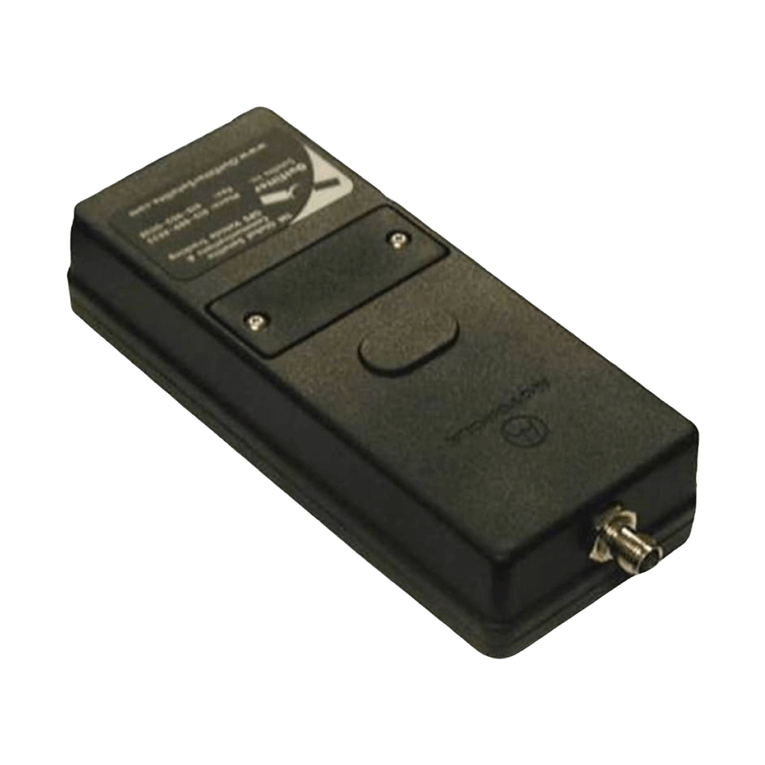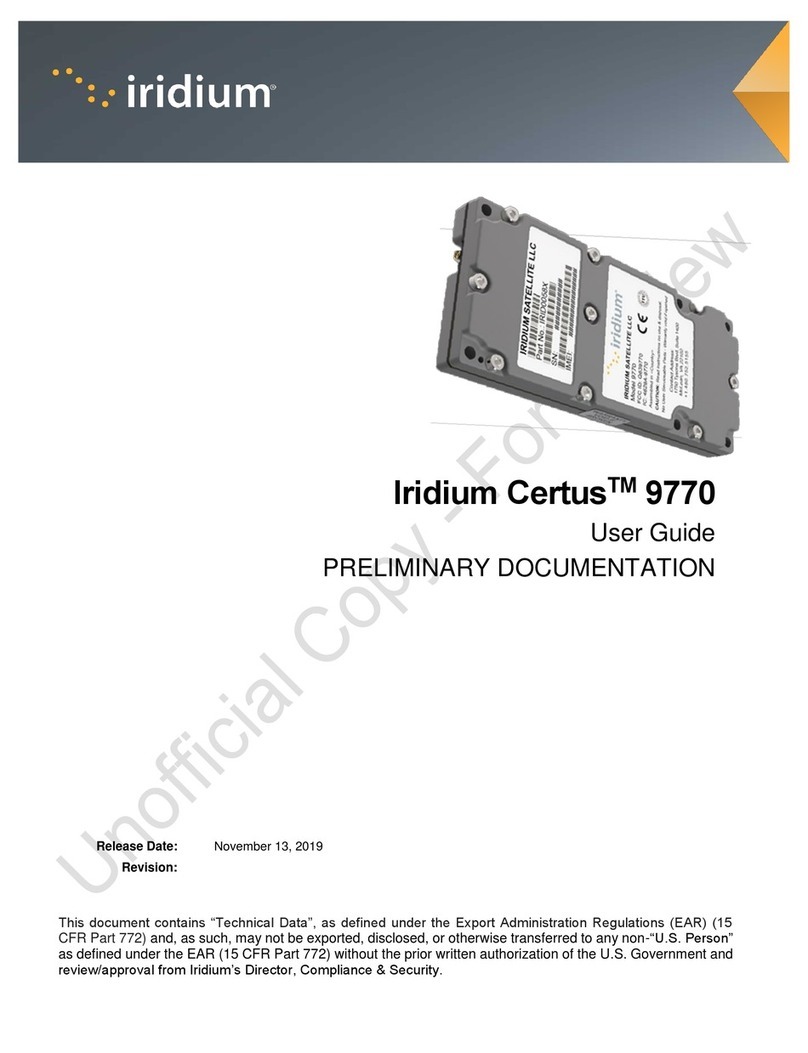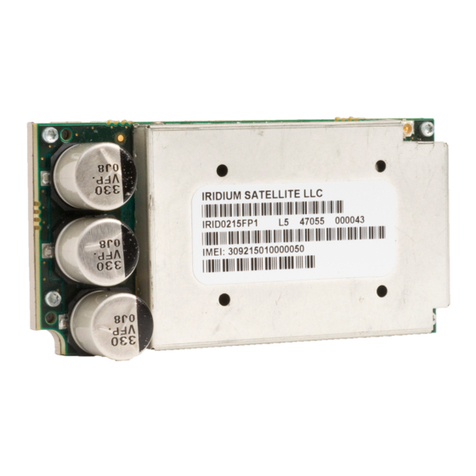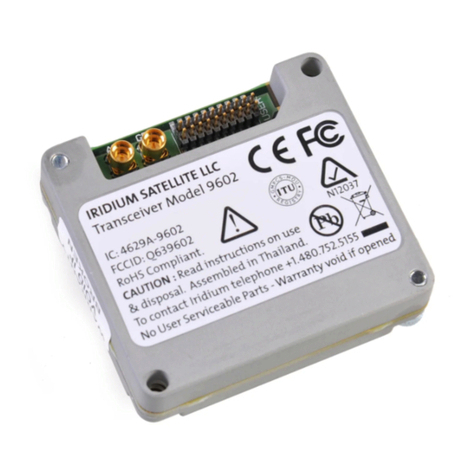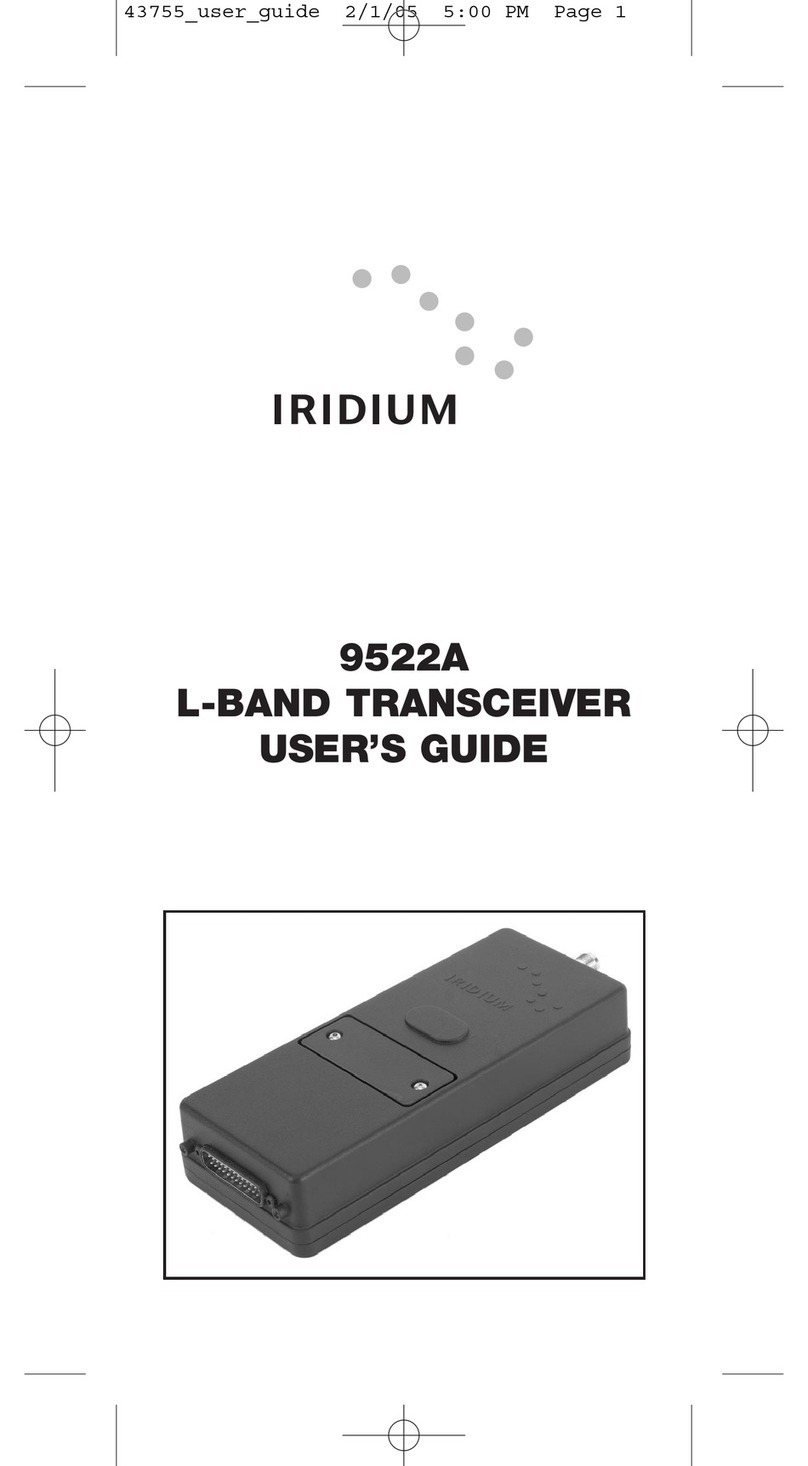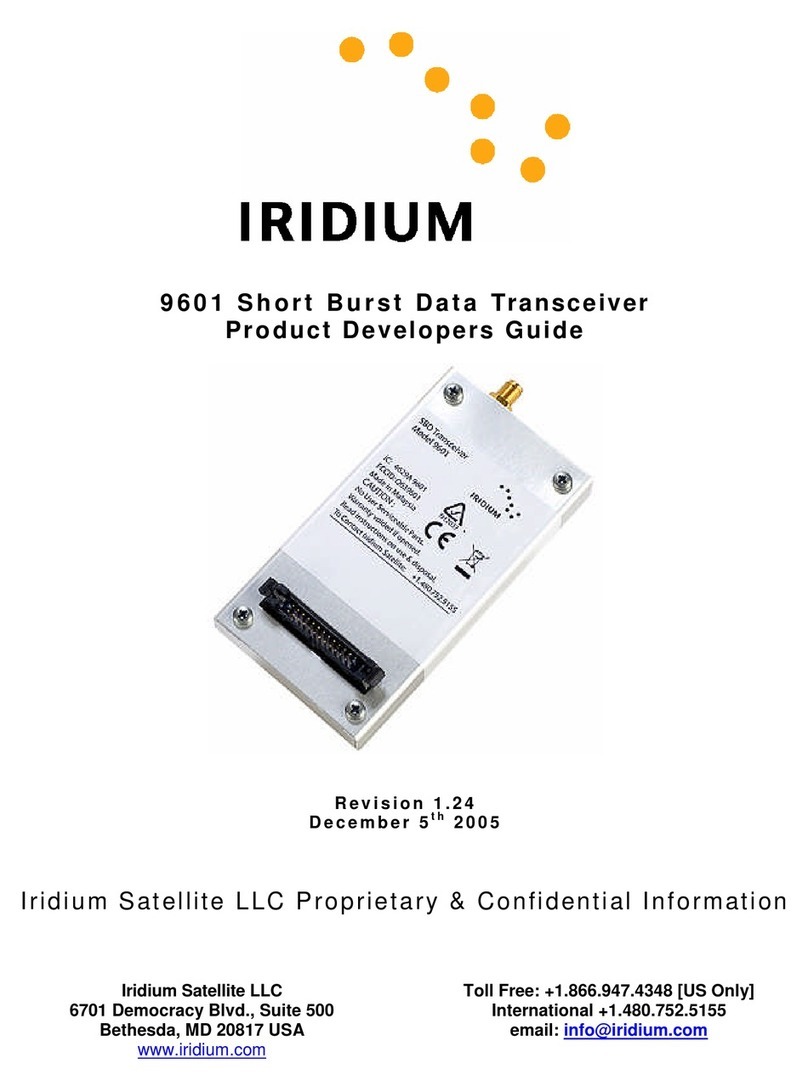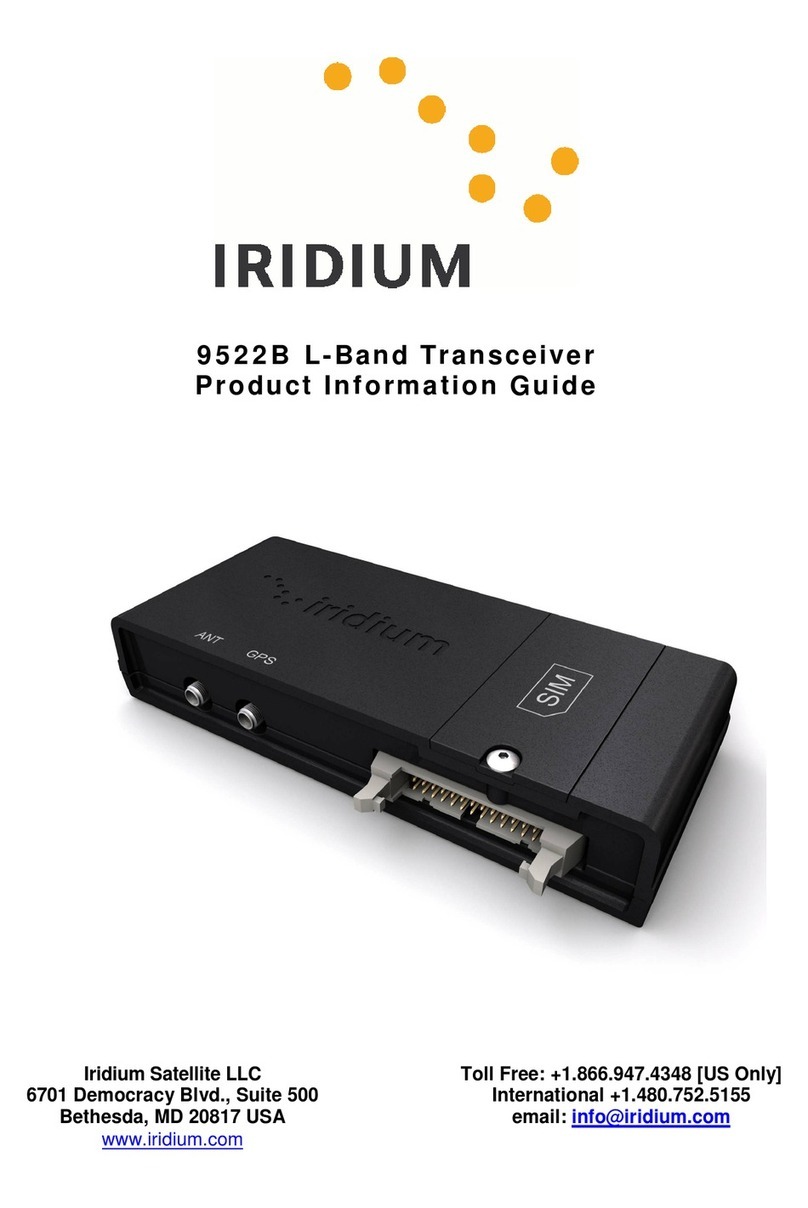
Iridium Communications, Inc. Information Contained in this Guide
Iridium 9523 Product Developer’s Guide is Subject to Change Without Notice
Revision 7.0
Iridium Communications, Inc. Distribution of Guide Restricted
Proprietary & Confidential Information Page 2 of 27 to Product Developers
Only
LEGAL DISCLAIMER AND CONDITIONS OF USE
This document contains information for the Iridium 9523 (“Product”) and is provided “as is.” The purpose
of providing such information is to enable Value Added Resellers and Value Added Manufacturers
(collectively, “Product Developer(s)”) to understand the Product and how to integrate it into a wireless
solution. Reasonable effort has been made to make the information in this document reliable and
consistent with specifications, test measurements and other information. However, Iridium
Communications Inc. and its affiliated companies, directors, officers, employees, agents, trustees or
consultants (“Iridium”) assume no responsibility for any typographical, technical, content or other
inaccuracies in this document. Iridium reserves the right in its sole discretion and without notice to you to
change Product specifications and materials and/or revise this document or withdraw it at any time. This
document is provided in conjunction with the purchase of the Product and is therefore subject to the
Product Sales Terms and Conditions set forth at http://www.Iridium.com/support/library/Legal
Notices.aspx. The Product Developer assumes any and all risk of using the Product specifications and
any other information provided.
Your use of this document is governed by your Partner Agreement with Iridium. Please review your
Partner Agreement and the Iridium Product Sales Terms and Conditions that govern your relationship
with Iridium. This document is strictly Proprietary and Confidential to Iridium. Consistent with your Partner
Agreement with Iridium, you may not this document (or any portion thereof) to others without express
written permission from Iridium. Any violation of your Agreement's Proprietary and Confidentiality
obligations shall result in remedies to the fullest extent available to Iridium at law or in equity.
IRIDIUM MAKES NO REPRESENTATIONS, GUARANTEES, CONDITIONS OR WARRANTIES,
EITHER EXPRESS OR IMPLIED, INCLUDING WITHOUT LIMITATION, ANY IMPLIED
REPRESENTATIONS, GUARANTEES, CONDITIONS OR WARRANTIES OF MERCHANTABILITY
AND FITNESS FOR A PARTICULAR PURPOSE, NON-INFRINGEMENT, SATISFACTORY QUALITY,
NON-INTERFERENCE, ACCURACY OF INFORMATIONAL CONTENT, OR ARISING FROM A
COURSE OF DEALING, LAW, USAGE, OR TRADE PRACTICE, USE, OR RELATED TO THE
PERFORMANCE OR NONPERFORMANCE OF ANY PRODUCTS AND/OR SERVICES
ACCESSORIES, FACILITIES OR SATELLITE SERVICES OR INFORMATION EXCEPT AS
EXPRESSLY STATED IN THIS DOCUMENT AND/OR THE PRODUCT AND/OR SATELLITE SERVICE
DOCUMENTATION. ANY OTHER STANDARDS OF PERFORMANCE, GUARANTEES, CONDITIONS
AND WARRANTIES ARE HEREBY EXPRESSLY EXCLUDED AND DISCLAIMED TO THE FULLEST
EXTENT PERMITTED BY LAW. THIS DISCLAIMER AND EXCLUSION SHALL APPLY EVEN IF THE
EXPRESS LIMITED WARRANTY CONTAINED IN SUCH DOCUMENTATION FAILS OF ITS
ESSENTIAL PURPOSE.
IN NO EVENT SHALL IRIDIUM BE LIABLE, REGARDLESS OF LEGAL THEORY, INCLUDING
WITHOUT LIMITATION CONTRACT, EXPRESS OR IMPLIED WARRANTY, STRICT LIABILITY,
GROSS NEGLIGENCE OR NEGLIGENCE, FOR ANY DAMAGES IN EXCESS OF THE PURCHASE
PRICE OF THIS DOCUMENT, IF ANY. NOR SHALL IRIDIUM BE LIABLE FOR ANY DIRECT,
INDIRECT, INCIDENTAL, SPECIAL OR CONSEQUENTIAL DAMAGES OF ANY KIND, OR LOSS OF
REVENUE OR PROFITS, LOSS OF BUSINESS, LOSS OF PRIVACY, LOSS OF USE, LOSS OF TIME
OR INCONVENIENCE, LOSS OF INFORMATION OR DATA, SOFTWARE OR APPLICATIONS OR
OTHER FINANCIAL LOSS CAUSED BY THE PRODUCT/SERVICE (INCLUDING HARDWARE,
SOFTWARE AND/OR FIRMWARE) AND/OR THE IRIDIUM SATELLITE SERVICES, OR ARISING OUT
OF OR IN CONNECTION WITH THE ABILITY OR INABILITY TO USE THE PRODUCT/SERVICE
(INCLUDING HARDWARE, SOFTWARE AND/OR FIRMWARE) AND/OR THE IRIDIUM SATELLITE
SERVICES TO THE FULLEST EXTENT THESE DAMAGES MAY BE DISCLAIMED BY LAW AND
WHETHER ADVISED OF THE POSSIBILITIES OF SUCH DAMAGES. IRIDIUM IS NOT LIABLE FOR
ANY CLAIM MADE BY A THIRD PARTY OR MADE BY YOU FOR A THIRD PARTY.
Your use of the information contained in this Guide is restricted to the development activity
authorized under the agreement(s) between you and Iridium, and is otherwise subject to all
